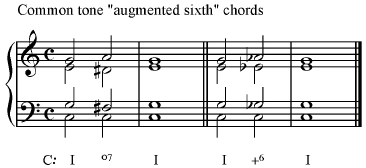Aldwell-Schachter Chapter 31
Click on a musical example for playback

natural-VII in major. The preparation has been achieved with the introduction of C-natural. In dealing with these chords the power of suggestion is as important as good voice-leading.

bVII without any preparation. This works primarily because bVII is being used as a passing harmony to V6/5.

VI# can function as V/ii. However, used here in a progression of descending thirds, the raised 3rd adds a poignancy to the progression that is not present otherwise.

Using VII5# generally requires some preparation, and leads effectively to V. Here a common-tone diminished seventh chord provides the F# and An necessary so the VII5natural is not a shock. Note that VII5natural sounds like V/iii – and iii contains common tones with V.

Preparing the chord isn’t absolutely necessary--#^5 isn’t such a shock, but it still helps to make a smooth transition.

Here the augmented chord is used without preparation and it still works just fine.

A V7 may augment the triad as well, producing a dominant seventh chord with an augmented fifth.
This has a kind of “augmented-sixth”-y sound, although it isn’t an augmented sixth chord.

V75b can appear in root position. It is more commonly encountered in the 43 position, where it behaves as an augmented sixth chord (43, or French) to i. It is conceivable in major, but the Phrygian aspect makes it more allied to minor.

Common-tone diminished seventh chord. It would be neither unseemly nor uncommon for the Eb to be spelled as D# in order to emphasize the lower neighbor.

The use of a common diminished seventh seems like a fancy gloss on I-V43-I63. It is a typically Tchaikovskian progression.

Note that the common-tone augmented sixth chord is more or less the same thing as a common-tone diminished seventh chord; thus, the best way to write one is to start with the diminished seventh and then create the quasi-augmented sixth. (In point of fact, it isn’t an augmented sixth chord at all.)

Even more slippery is the common-tone “dominant seventh chord”. It is also a kind of very fancy common-tone diminished seventh chord. In this first example, a decorated neighboring iv64 provides Schubert’s original harmony.

In the passage in the major, Schubert uses approximately the same tones as in the minor key, but decorates them to create a quasi-dominant 4/2. In fact, with the addition of an E#, this chord would be yet again another common-tone diminished seventh chord—thus again providing us with a modus operandi for writing such harmonies.